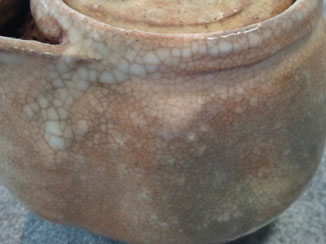Hagi yaki Pottery ( Hagi-yaki) is one of the most famous pottery types in Japan.
-History-
The skills for making this craft was imported into Japan from Korea in the early 1600s. Hagi ware flourished during the Edo Period (1603-1867) and was highly prized as tea wares for the tea ceremony.
The color of Hagiyaki Pottery changes over time with use, as tea residuals enter the miniscule openings on its surface. Clay used for Hagi ware is coarse, and due to its texture, color of ware is unique. Since the color changes as you use, the process is called "Hagi's seven changes (Hagi no Shichibake)" This characteristic is highly appreciated by tea enthusiasts. Hagiyaki Pottery remains popular to this day.
[About water repellent processing]
Hagi ware has a fine crack of glaze called "Craze" on the surface of pottery. Through this intrusion, we are giving a soft gloss and texture unique to pottery. The color of Hagi ware changes over time with use, as tea residuals enter the miniscule openings on its surface. Clay used for Hagi ware is coarse, and due to its texture, color of ware is unique. Since the color changes as you use, the process is called "Hagi's seven changes (Hagi no Shichibake)" This characteristic is highly appreciated by tea enthusiasts.

[How to handle Hagi ware ]
1 Before each use, let the ceramics sit and absorb plenty of water for about 30 minutes. This prevents the tea from soaking into the ceramics and causing tea-stains.
Unlike the glazed type of ceramics, Hagiyaki is rough in nature and may leak in the early stages of use. With repeated usage, the seeping of tea incrustations will eventually seal it and the leaking will stop. If leaking continues, dry the ceramics well, mix 1 tablespoon of cornstarch into 500cc of water, boil and pour into the ceramics. Let sit for 6 hours and leaking will stop.
2 When ceramics are used with strong foods such as acidity, oils and alcoholic beverages, they penetrate and become stains, offensive odors, stickiness, so please avoid keeping this liquid for long time. Before use, if you soak in water and let the water suck up enough, it will be difficult to suck the liquid of the dish and the greasiness. As we continue to use it, the color gradually follows the intrusion, but since this change in texture is one of the characteristics of Hagi ware, you can enjoy the secular change.
3 Please dry well before storing Hagi ware. If there is moisture, it may cause mold. Especially for Hagi ware, it is easy to absorb moisture, so please dry completely before storing it.
Do not use in microwave ovens. The glaze may become discolored or the ceramics may break at extreme high temperatures.
※ Due to the characteristics of Hagi ware, colors, patterns, shapes, etc. may differ slightly.
Please enjoy the slightly different charm of each facial expression.

